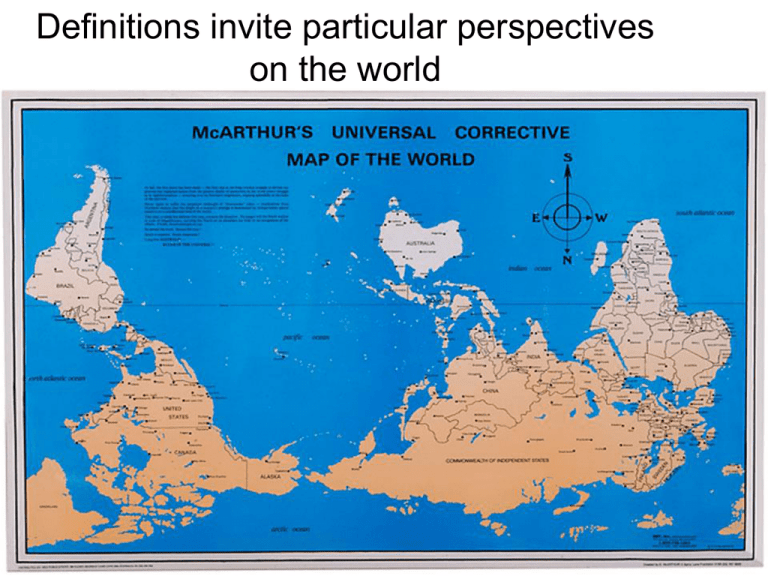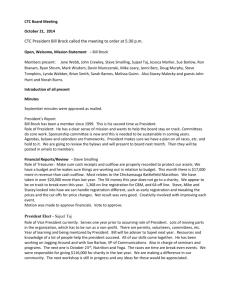The Politics of Definition
advertisement

Definitions invite particular perspectives on the world The Politics of Definition Consider how the following definitions and terms involve questions of power, value and ideology 1. Mr, Mrs, Miss (Ms.) defines women in terms of their marital status, but not men (hence Ms.) The convention of women being identified by the last name of their father or husband. 2. “Enhanced interrogation,” “enemy combatants,” “war on terror,” “axis of evil” 3. “Far East, Middle East, Near East” (defining regions wrt proximity to Britain) 4. MEDICINE: The re/definition and medicalization of illness: “male pattern baldness” (going bald) “social anxiety disorder” (shyness) “ED, or erectile dysfunction” (formerly impotence) “halitosis (bad breath) 5. PSYCHOLOGY: APA redefines homosexuality in 1972 (before 1972 it is listed as a mental illness); the many shifting re/definitions of conditions, from hysteria to depression to sexual identity (trans-gender, transexual, bisexual, etc.) The Politics of Definition 6. RACE: the one drop rule; Negro, Black, African American; miscegenation laws. In South Africa the Japanese are defined as white, as Japan = key trading partner. Others are black or colored (Asian). In Brazil, definitions of race are particularly varied. In the U.S., “Caucasian” has been redefined many times – sometimes includes people from India, Afghanistan, Turkey, and the Mediterranean countries, and at other times (esp. wrt immigration) not. Consider Germany – citizenship is largely defined in terms of racial/ethnic and national “descent” rather than place (unlike in the U.S., the children of foreigners assume their parents' nationality.) In most countries, racial definitions shift frequently, shaped by ideology, power, economics and history. Consider the terms Maori and Pakeha in NZ. 7. SOCIAL ISSUES: drugs and alcoholism as moral failings vs. addictions. 8. LEGAL DEFINITIONS: the recent supreme court case ruling on the free speech rights of corporations; defining rape within marriage as a crime (for a long time it wasn’t in many countries) 9. How should we re/define marriage (debates about gay marriage). Is marriage primarily to be defined as religious, as about procreation, stability and other social goods, a love relationship, etc. APA conference 1972 Gay psychologist wears a mask at the American Psychological Association conference in 1972. He is on a panel arguing that APA definitions of homosexuality as a mental illness should be abolished Definition of Caucasian: 1932 The Races of Men, Smallwood et al. 1952, p. 264 (cited by Morning, 2008 • In the United States, the term ‘Caucasian’ has been mainly used to describe a group commonly called White Americans, as defined by the government and Census Bureau.[22] Between 1917 and 1965, immigration to the US was restricted by a national origins quota. The Supreme Court in United States v. Bhagat Singh Thind (1923) decided that Asian Indians – unlike Europeans and Middle Easterners – were Caucasian, but were not white, because most laypeople did not consider them to be white people. This was important for determining whether they could become naturalized citizens, then limited to free whites. The court and government changed its opinion in 1946. In 1965 major changes were made to immigration law, lifting earlier restrictions on immigrants from Asia.[23] (Wikipedia) Definition of Caucasian: 1932 • “In the United States, the term Caucasian has been mainly used to describe a group commonly called White Americans, as defined by the government and Census Bureau.[22] Between 1917 and 1965, immigration to the US was restricted by a national origins quota. The Supreme Court in United States v. Bhagat Singh Thind (1923) decided that Asian Indians – unlike Europeans and Middle Easterners – were Caucasian, but were not white, because most laypeople did not consider them to be white people. This was important for determining whether they could become naturalized citizens, then limited to free whites. The court and government changed its opinion in 1946. In 1965 major changes were made to immigration law, lifting earlier restrictions on immigrants from Asia.[23]” (Wikipedia) http://en.wikipedia.org/wiki/Caucasian_race The Races of Men, Smallwood et al. 1952, p. 264 (cited by Morning, 2008 Five Major Human Races” (Oram et al. 1976, p. 614) • “There is no more biological reason to speak of the Indians, Whites, and Blacks as distinct races than there is to speak of red-haired, brownhaired, and gray-haired people as distinct races. This is not to say that races are not “real.” They are all too real, but understanding how races are formed and perpetuated in societies is a matter of looking into social history, not biology.” “Two Anthropologists Reflect on Race & Racism What is Race? An Anthropological View.” By Thomas Bilosi and Marc Feldesman, DIVERSITY Vol.2 1992.











